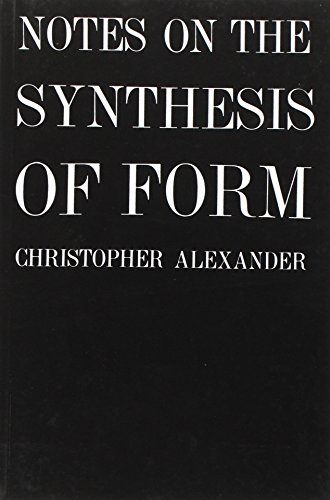notes synthesis form di christopher alexander (40 risultati)
Filtri di ricerca
Tipo di articolo
- Tutti i tipi di prodotto
- Libri (40)
- Riviste e Giornali (Nessun altro risultato corrispondente a questo perfezionamento)
- Fumetti (Nessun altro risultato corrispondente a questo perfezionamento)
- Spartiti (Nessun altro risultato corrispondente a questo perfezionamento)
- Arte, Stampe e Poster (Nessun altro risultato corrispondente a questo perfezionamento)
- Fotografie (Nessun altro risultato corrispondente a questo perfezionamento)
- Mappe (Nessun altro risultato corrispondente a questo perfezionamento)
- Manoscritti e Collezionismo cartaceo (Nessun altro risultato corrispondente a questo perfezionamento)
Condizioni Maggiori informazioni
- Nuovo (21)
- Come nuovo, Ottimo o Quasi ottimo (3)
- Molto buono o Buono (12)
- Discreto o Mediocre (4)
- Come descritto (Nessun altro risultato corrispondente a questo perfezionamento)
Legatura
Ulteriori caratteristiche
- Prima ed. (3)
- Copia autograf. (Nessun altro risultato corrispondente a questo perfezionamento)
- Sovracoperta (3)
- Con foto (20)
- Non Print on Demand (40)
Lingua (2)
Spedizione gratuita
Paese del venditore
Valutazione venditore
-
Notes on the Synthesis of Form (Harvard Paperbacks)
Da: Goodwill Southern California, Los Angeles, CA, U.S.A.
EUR 12,38
Convertire valutaEUR 2,59 per la spedizione in U.S.A.Quantità: 1 disponibili
Aggiungi al carrelloCondizione: good.
-
EUR 12,39
Convertire valutaEUR 3,23 per la spedizione in U.S.A.Quantità: 1 disponibili
Aggiungi al carrelloPaperback. Condizione: Good. Connecting readers with great books since 1972! Used textbooks may not include companion materials such as access codes, etc. May have some wear or writing/highlighting. We ship orders daily and Customer Service is our top priority!
-
Notes on the Synthesis of Form (Harvard Paperbacks)
Da: Bay State Book Company, North Smithfield, RI, U.S.A.
EUR 15,93
Convertire valutaGratis per la spedizione in U.S.A.Quantità: 1 disponibili
Aggiungi al carrelloCondizione: acceptable. The book is complete and readable, with all pages and cover intact. Dust jacket, shrink wrap, or boxed set case may be missing. Pages may have light notes, highlighting, or minor water exposure, but nothing that affects readability. May be an ex-library copy and could include library markings or stickers.
-
EUR 12,39
Convertire valutaEUR 3,44 per la spedizione in U.S.A.Quantità: 1 disponibili
Aggiungi al carrelloCondizione: acceptable. Fairly worn, but readable and intact. If applicable: Dust jacket, disc or access code may not be included.
-
EUR 20,58
Convertire valutaGratis per la spedizione in U.S.A.Quantità: 1 disponibili
Aggiungi al carrelloCondizione: Good. Used book that is in clean, average condition without any missing pages.
-
EUR 29,59
Convertire valutaEUR 2,28 per la spedizione in U.S.A.Quantità: 2 disponibili
Aggiungi al carrelloCondizione: New.
-
Notes on the Synthesis of Form (Paperback)
Editore: Harvard University Press, Cambridge, Mass, 1964
ISBN 10: 0674627512 ISBN 13: 9780674627512
Lingua: Inglese
Da: Grand Eagle Retail, Bensenville, IL, U.S.A.
EUR 31,95
Convertire valutaGratis per la spedizione in U.S.A.Quantità: 1 disponibili
Aggiungi al carrelloPaperback. Condizione: new. Paperback. "These notes are about the process of design: the process of inventing things which display new physical order, organization, form, in response to function." This book, opening with these words, presents an entirely new theory of the process of design.In the first part of the book, Christopher Alexander discusses the process by which a form is adapted to the context of human needs and demands that has called it into being. He shows that such an adaptive process will be successful only if it proceeds piecemeal instead of all at once. It is for this reason that forms from traditional un-self-conscious cultures, molded not by designers but by the slow pattern of changes within tradition, are so beautifully organized and adapted. When the designer, in our own self-conscious culture, is called on to create a form that is adapted to its context he is unsuccessful, because the preconceived categories out of which he builds his picture of the problem do not correspond to the inherent components of the problem, and therefore lead only to the arbitrariness, willfulness, and lack of understanding which plague the design of modern buildings and modern cities.In the second part, Mr. Alexander presents a method by which the designer may bring his full creative imagination into play, and yet avoid the traps of irrelevant preconception. He shows that, whenever a problem is stated, it is possible to ignore existing concepts and to create new concepts, out of the structure of the problem itself, which do correspond correctly to what he calls the subsystems of the adaptive process. By treating each of these subsystems as a separate subproblem, the designer can translate the new concepts into form. The form, because of the process, will be well-adapted to its context, non-arbitrary, and correct.The mathematics underlying this method, based mainly on set theory, is fully developed in a long appendix. Another appendix demonstrates the application of the method to the design of an Indian village. "These notes are about the process of design: the process of inventing things which display new physical order, organization, form, in response to function." This book, opening with these words, presents an entirely new theory on the process of design. Shipping may be from multiple locations in the US or from the UK, depending on stock availability.
-
EUR 31,41
Convertire valutaEUR 2,28 per la spedizione in U.S.A.Quantità: 2 disponibili
Aggiungi al carrelloCondizione: As New. Unread book in perfect condition.
-
Notes on the Synthesis of Form
Editore: Harvard University Press, US, 1964
ISBN 10: 0674627512 ISBN 13: 9780674627512
Lingua: Inglese
Da: Rarewaves.com USA, London, LONDO, Regno Unito
EUR 33,96
Convertire valutaGratis per la spedizione da Regno Unito a U.S.A.Quantità: Più di 20 disponibili
Aggiungi al carrelloPaperback. Condizione: New. "These notes are about the process of design: the process of inventing things which display new physical order, organization, form, in response to function." This book, opening with these words, presents an entirely new theory of the process of design.In the first part of the book, Christopher Alexander discusses the process by which a form is adapted to the context of human needs and demands that has called it into being. He shows that such an adaptive process will be successful only if it proceeds piecemeal instead of all at once. It is for this reason that forms from traditional un-self-conscious cultures, molded not by designers but by the slow pattern of changes within tradition, are so beautifully organized and adapted. When the designer, in our own self-conscious culture, is called on to create a form that is adapted to its context he is unsuccessful, because the preconceived categories out of which he builds his picture of the problem do not correspond to the inherent components of the problem, and therefore lead only to the arbitrariness, willfulness, and lack of understanding which plague the design of modern buildings and modern cities.In the second part, Mr. Alexander presents a method by which the designer may bring his full creative imagination into play, and yet avoid the traps of irrelevant preconception. He shows that, whenever a problem is stated, it is possible to ignore existing concepts and to create new concepts, out of the structure of the problem itself, which do correspond correctly to what he calls the subsystems of the adaptive process. By treating each of these subsystems as a separate subproblem, the designer can translate the new concepts into form. The form, because of the process, will be well-adapted to its context, non-arbitrary, and correct.The mathematics underlying this method, based mainly on set theory, is fully developed in a long appendix. Another appendix demonstrates the application of the method to the design of an Indian village.
-
EUR 29,60
Convertire valutaEUR 4,78 per la spedizione da Regno Unito a U.S.A.Quantità: 15 disponibili
Aggiungi al carrelloPAP. Condizione: New. New Book. Shipped from UK. Established seller since 2000.
-
Notes on the Synthesis of Form (Revised)
Editore: Harvard University Press January 1964, 1964
ISBN 10: 0674627512 ISBN 13: 9780674627512
Lingua: Inglese
Da: Eighth Day Books, LLC, Wichita, KS, U.S.A.
EUR 30,18
Convertire valutaEUR 5,13 per la spedizione in U.S.A.Quantità: 2 disponibili
Aggiungi al carrelloPaper Back. Condizione: New.
-
Notes on The Synthesis of Form
Editore: Harvard University Press, Printed in USA, 1964
ISBN 10: 0674627512 ISBN 13: 9780674627512
Lingua: Inglese
Da: Acadia Art & Rare Books. Est. 1931, Toronto, ON, Canada
EUR 31,60
Convertire valutaEUR 5,17 per la spedizione da Canada a U.S.A.Quantità: 1 disponibili
Aggiungi al carrelloCondizione: Near Fine. Softcover. 8vo. 216pp. Illustrations in b/w. Slight wear to covers. Clean and unmarked interior.
-
EUR 35,09
Convertire valutaEUR 5,50 per la spedizione da Italia a U.S.A.Quantità: Più di 20 disponibili
Aggiungi al carrelloCondizione: new.
-
EUR 27,16
Convertire valutaEUR 17,23 per la spedizione da Canada a U.S.A.Quantità: 2 disponibili
Aggiungi al carrelloPaperback. Condizione: New. Later Pr. Special order direct from the distributor.
-
Notes on the Synthesis of Form
Editore: Harvard University Press, US, 1964
ISBN 10: 0674627512 ISBN 13: 9780674627512
Lingua: Inglese
Da: Rarewaves USA, OSWEGO, IL, U.S.A.
EUR 45,41
Convertire valutaGratis per la spedizione in U.S.A.Quantità: 1 disponibili
Aggiungi al carrelloPaperback. Condizione: New. "These notes are about the process of design: the process of inventing things which display new physical order, organization, form, in response to function." This book, opening with these words, presents an entirely new theory of the process of design.In the first part of the book, Christopher Alexander discusses the process by which a form is adapted to the context of human needs and demands that has called it into being. He shows that such an adaptive process will be successful only if it proceeds piecemeal instead of all at once. It is for this reason that forms from traditional un-self-conscious cultures, molded not by designers but by the slow pattern of changes within tradition, are so beautifully organized and adapted. When the designer, in our own self-conscious culture, is called on to create a form that is adapted to its context he is unsuccessful, because the preconceived categories out of which he builds his picture of the problem do not correspond to the inherent components of the problem, and therefore lead only to the arbitrariness, willfulness, and lack of understanding which plague the design of modern buildings and modern cities.In the second part, Mr. Alexander presents a method by which the designer may bring his full creative imagination into play, and yet avoid the traps of irrelevant preconception. He shows that, whenever a problem is stated, it is possible to ignore existing concepts and to create new concepts, out of the structure of the problem itself, which do correspond correctly to what he calls the subsystems of the adaptive process. By treating each of these subsystems as a separate subproblem, the designer can translate the new concepts into form. The form, because of the process, will be well-adapted to its context, non-arbitrary, and correct.The mathematics underlying this method, based mainly on set theory, is fully developed in a long appendix. Another appendix demonstrates the application of the method to the design of an Indian village.
-
EUR 46,16
Convertire valutaGratis per la spedizione in U.S.A.Quantità: 1 disponibili
Aggiungi al carrelloHardcover. Condizione: Good. No Jacket. Ninth printing. Shelf and handling wear to cover and binding, with general signs of previous use. No notes, inscriptions or underlining to text. Secure packaging for safe delivery.
-
EUR 31,91
Convertire valutaEUR 17,22 per la spedizione da Regno Unito a U.S.A.Quantità: 2 disponibili
Aggiungi al carrelloCondizione: New.
-
EUR 42,88
Convertire valutaEUR 7,46 per la spedizione da Regno Unito a U.S.A.Quantità: 3 disponibili
Aggiungi al carrelloCondizione: New. pp. 224.
-
EUR 34,00
Convertire valutaEUR 16,13 per la spedizione da Regno Unito a U.S.A.Quantità: Più di 20 disponibili
Aggiungi al carrelloPaperback / softback. Condizione: New. New copy - Usually dispatched within 4 working days. 330.
-
EUR 48,84
Convertire valutaEUR 3,44 per la spedizione in U.S.A.Quantità: 3 disponibili
Aggiungi al carrelloCondizione: New. pp. 224.
-
Notes on the Synthesis of Form (Harvard Paperbacks)
Da: Ria Christie Collections, Uxbridge, Regno Unito
EUR 39,13
Convertire valutaEUR 13,75 per la spedizione da Regno Unito a U.S.A.Quantità: Più di 20 disponibili
Aggiungi al carrelloCondizione: New. In.
-
EUR 37,22
Convertire valutaEUR 17,22 per la spedizione da Regno Unito a U.S.A.Quantità: 2 disponibili
Aggiungi al carrelloCondizione: As New. Unread book in perfect condition.
-
Notes on the Synthesis of Form (Paperback)
Editore: Harvard University Press, Cambridge, Mass, 1964
ISBN 10: 0674627512 ISBN 13: 9780674627512
Lingua: Inglese
Da: AussieBookSeller, Truganina, VIC, Australia
EUR 28,39
Convertire valutaEUR 31,89 per la spedizione da Australia a U.S.A.Quantità: 1 disponibili
Aggiungi al carrelloPaperback. Condizione: new. Paperback. "These notes are about the process of design: the process of inventing things which display new physical order, organization, form, in response to function." This book, opening with these words, presents an entirely new theory of the process of design.In the first part of the book, Christopher Alexander discusses the process by which a form is adapted to the context of human needs and demands that has called it into being. He shows that such an adaptive process will be successful only if it proceeds piecemeal instead of all at once. It is for this reason that forms from traditional un-self-conscious cultures, molded not by designers but by the slow pattern of changes within tradition, are so beautifully organized and adapted. When the designer, in our own self-conscious culture, is called on to create a form that is adapted to its context he is unsuccessful, because the preconceived categories out of which he builds his picture of the problem do not correspond to the inherent components of the problem, and therefore lead only to the arbitrariness, willfulness, and lack of understanding which plague the design of modern buildings and modern cities.In the second part, Mr. Alexander presents a method by which the designer may bring his full creative imagination into play, and yet avoid the traps of irrelevant preconception. He shows that, whenever a problem is stated, it is possible to ignore existing concepts and to create new concepts, out of the structure of the problem itself, which do correspond correctly to what he calls the subsystems of the adaptive process. By treating each of these subsystems as a separate subproblem, the designer can translate the new concepts into form. The form, because of the process, will be well-adapted to its context, non-arbitrary, and correct.The mathematics underlying this method, based mainly on set theory, is fully developed in a long appendix. Another appendix demonstrates the application of the method to the design of an Indian village. "These notes are about the process of design: the process of inventing things which display new physical order, organization, form, in response to function." This book, opening with these words, presents an entirely new theory on the process of design. Shipping may be from our Sydney, NSW warehouse or from our UK or US warehouse, depending on stock availability.
-
EUR 41,00
Convertire valutaEUR 28,70 per la spedizione da Regno Unito a U.S.A.Quantità: 2 disponibili
Aggiungi al carrelloPaperback. Condizione: Brand New. later pr. edition. 224 pages. 8.25x5.50x0.75 inches. In Stock.
-
Notes on the Synthesis of Form (Paperback)
Editore: Harvard University Press, Cambridge, Mass, 1964
ISBN 10: 0674627512 ISBN 13: 9780674627512
Lingua: Inglese
Da: CitiRetail, Stevenage, Regno Unito
EUR 31,92
Convertire valutaEUR 42,48 per la spedizione da Regno Unito a U.S.A.Quantità: 1 disponibili
Aggiungi al carrelloPaperback. Condizione: new. Paperback. "These notes are about the process of design: the process of inventing things which display new physical order, organization, form, in response to function." This book, opening with these words, presents an entirely new theory of the process of design.In the first part of the book, Christopher Alexander discusses the process by which a form is adapted to the context of human needs and demands that has called it into being. He shows that such an adaptive process will be successful only if it proceeds piecemeal instead of all at once. It is for this reason that forms from traditional un-self-conscious cultures, molded not by designers but by the slow pattern of changes within tradition, are so beautifully organized and adapted. When the designer, in our own self-conscious culture, is called on to create a form that is adapted to its context he is unsuccessful, because the preconceived categories out of which he builds his picture of the problem do not correspond to the inherent components of the problem, and therefore lead only to the arbitrariness, willfulness, and lack of understanding which plague the design of modern buildings and modern cities.In the second part, Mr. Alexander presents a method by which the designer may bring his full creative imagination into play, and yet avoid the traps of irrelevant preconception. He shows that, whenever a problem is stated, it is possible to ignore existing concepts and to create new concepts, out of the structure of the problem itself, which do correspond correctly to what he calls the subsystems of the adaptive process. By treating each of these subsystems as a separate subproblem, the designer can translate the new concepts into form. The form, because of the process, will be well-adapted to its context, non-arbitrary, and correct.The mathematics underlying this method, based mainly on set theory, is fully developed in a long appendix. Another appendix demonstrates the application of the method to the design of an Indian village. "These notes are about the process of design: the process of inventing things which display new physical order, organization, form, in response to function." This book, opening with these words, presents an entirely new theory on the process of design. Shipping may be from our UK warehouse or from our Australian or US warehouses, depending on stock availability.
-
EUR 75,79
Convertire valutaEUR 5,99 per la spedizione in U.S.A.Quantità: 1 disponibili
Aggiungi al carrellopaperback. Condizione: New. In shrink wrap. Looks like an interesting title!
-
EUR 82,69
Convertire valutaGratis per la spedizione in U.S.A.Quantità: 1 disponibili
Aggiungi al carrelloCondizione: good. A copy that has been read, remains in good condition. All pages are intact, and the cover is intact. The spine and cover show signs of wear. Pages can include notes and highlighting and show signs of wear, and the copy can include "From the library of" labels or previous owner inscriptions. 100% GUARANTEE! Shipped with delivery confirmation, if you're not satisfied with purchase please return item for full refund. Ships via media mail.
-
EUR 83,58
Convertire valutaGratis per la spedizione in U.S.A.Quantità: 1 disponibili
Aggiungi al carrelloHardcover. Condizione: Fair. No Jacket. Readable copy. Pages may have considerable notes/highlighting. ~ ThriftBooks: Read More, Spend Less.
-
EUR 83,58
Convertire valutaGratis per la spedizione in U.S.A.Quantità: 1 disponibili
Aggiungi al carrelloHardcover. Condizione: Good. No Jacket. Pages can have notes/highlighting. Spine may show signs of wear. ~ ThriftBooks: Read More, Spend Less.
-
Notes on the Synthesis of Form
Editore: Harvard University Press, US, 1964
ISBN 10: 0674627512 ISBN 13: 9780674627512
Lingua: Inglese
Da: Rarewaves USA United, OSWEGO, IL, U.S.A.
EUR 47,19
Convertire valutaEUR 43,09 per la spedizione in U.S.A.Quantità: 1 disponibili
Aggiungi al carrelloPaperback. Condizione: New. "These notes are about the process of design: the process of inventing things which display new physical order, organization, form, in response to function." This book, opening with these words, presents an entirely new theory of the process of design.In the first part of the book, Christopher Alexander discusses the process by which a form is adapted to the context of human needs and demands that has called it into being. He shows that such an adaptive process will be successful only if it proceeds piecemeal instead of all at once. It is for this reason that forms from traditional un-self-conscious cultures, molded not by designers but by the slow pattern of changes within tradition, are so beautifully organized and adapted. When the designer, in our own self-conscious culture, is called on to create a form that is adapted to its context he is unsuccessful, because the preconceived categories out of which he builds his picture of the problem do not correspond to the inherent components of the problem, and therefore lead only to the arbitrariness, willfulness, and lack of understanding which plague the design of modern buildings and modern cities.In the second part, Mr. Alexander presents a method by which the designer may bring his full creative imagination into play, and yet avoid the traps of irrelevant preconception. He shows that, whenever a problem is stated, it is possible to ignore existing concepts and to create new concepts, out of the structure of the problem itself, which do correspond correctly to what he calls the subsystems of the adaptive process. By treating each of these subsystems as a separate subproblem, the designer can translate the new concepts into form. The form, because of the process, will be well-adapted to its context, non-arbitrary, and correct.The mathematics underlying this method, based mainly on set theory, is fully developed in a long appendix. Another appendix demonstrates the application of the method to the design of an Indian village.



















